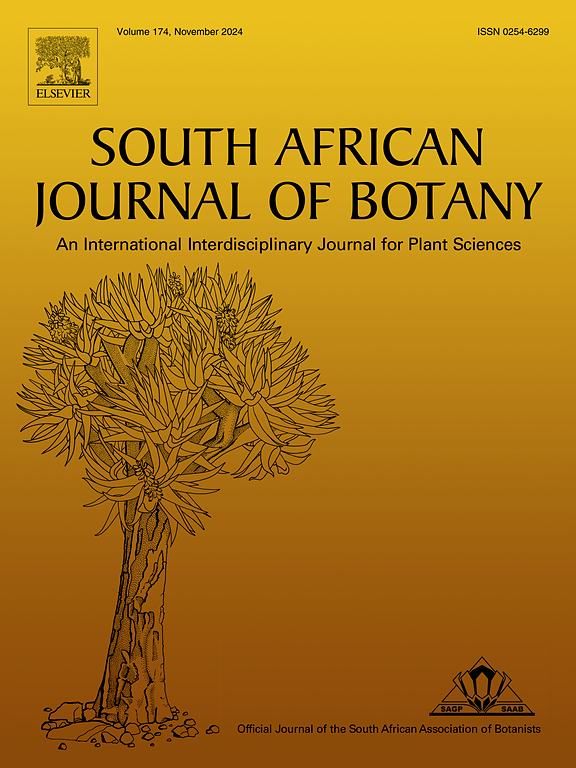一些非角龙舌兰和龙舌兰属(龙舌兰科,龙舌兰科)的木材解剖:次生木质部对气候的结构响应和火后再生策略
IF 2.7
3区 生物学
Q2 PLANT SCIENCES
引用次数: 0
摘要
本研究探讨了Proteeae (Proteaceae)部落(Protea属和Faurea属)木材结构多样性的模式。对分布在开普区以外的4种Protea种(P. afra, P. gaguedi, P. roupelliae, P. welwitschii)和2种动物类(F. saligna和F. rochetiana)的木材结构进行了研究。我们的数据与Stepanova等人(2021)对Protea的Faurea和Cape物种的研究结果相结合,创建了一个统一的数据集,用于分析木材性状、气候因素和火灾后再生策略(种子与再生)之间的相关性。我们发现纤维壁上凹坑边界的大小与容器分组与地中海型气候的表达呈正相关,而容器分组与地中海型气候的表达呈正相关。这些发现表明,Proteeae在应对季节性水分胁迫方面的适应策略发生了转变:受冬季降雨和夏季干旱影响的Cape物种通常表现出孤立的容器和导水的地面组织,而来自夏季潮湿和冬季干燥地区的非Cape物种往往具有较大的容器群和不导水的地面组织。此外,射线大小和/或频率的减少与地中海型气候有关,这与在南部非洲生物群落中观察到的更广泛的模式一致。在蛋白质科中,播种机通常比播种机有更高的导管频率、更大的导管间坑和更窄的射线。播种机的容器频率越高,其抗空化能力也越强,这对于应对水分胁迫至关重要,因为它们的根很浅。较大的容器间坑也可能反映了对水压力的适应,尽管它们的确切水力作用尚不清楚。再生路由器中较宽的射线可能在淀粉储存中起作用,用于火灾后再生,并可能作为外胚芽形成的地点,这对再生至关重要。本文章由计算机程序翻译,如有差异,请以英文原文为准。
Wood anatomy of some non-Cape Protea and Faurea species (Proteeae, Proteaceae): structural responses of secondary xylem to climate and post-fire regeneration strategies
This study investigates patterns of wood structural diversity within the tribe Proteeae (Proteaceae), which includes the genera Protea and Faurea. We examined the wood structure of four Protea species (P. afra, P. gaguedi, P. roupelliae, P. welwitschii) and two Faurea species (F. saligna and F. rochetiana) distributed outside the Cape Floristic Region. Our data were combined with results from Stepanova et al. (2021) on Faurea and Cape species of Protea, creating a unified dataset for analyzing correlations between wood traits, climatic factors, and post-fire regeneration strategies (seeders vs resprouters). We found a positive correlation between the size of pit borders on fiber walls and a negative correlation between vessel grouping and the expression of Mediterranean-type climate. These findings suggest a shift in adaptive strategies within Proteeae in response to seasonal water stress: Cape species, influenced by winter rainfall and summer drought, typically exhibit solitary vessels and water-conducting ground tissue, while non-Cape species from regions with moist summers and dry winters tend to have larger vessel groups and non-conducting ground tissue. Additionally, the reduction in ray size and/or frequency associated with a Mediterranean-type climate aligning with broader patterns observed across southern African biomes. Within Proteeae, seeders generally have higher vessel frequency, larger intervessel pits, and narrower rays compared to resprouters. The higher vessel frequency in seeders is consistent with their greater cavitation resistance, which is critical for coping with water stress due to their shallow roots. Larger intervessel pits may also reflect adaptation to water stress, though their precise hydraulic role remains unclear. The wider rays in resprouters likely play a role in starch storage for post-fire regeneration and may serve as sites for adventitious epicormic bud formation, which is vital for resprouting.
求助全文
通过发布文献求助,成功后即可免费获取论文全文。
去求助
来源期刊

South African Journal of Botany
生物-植物科学
CiteScore
5.20
自引率
9.70%
发文量
709
审稿时长
61 days
期刊介绍:
The South African Journal of Botany publishes original papers that deal with the classification, biodiversity, morphology, physiology, molecular biology, ecology, biotechnology, ethnobotany and other botanically related aspects of species that are of importance to southern Africa. Manuscripts dealing with significant new findings on other species of the world and general botanical principles will also be considered and are encouraged.
 求助内容:
求助内容: 应助结果提醒方式:
应助结果提醒方式:


